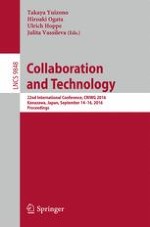This book constitutes the refereed proceedings of the 22nd International Conference on Collaboration and Technology, CRIWG 2016, held in Kanazawa, Japan, in September 2016.
The 10 revised full papers presented together with 3 work-in-progress papers werecarefully reviewed and selected from 27 submissions. The papers reflect the current diversity of collaborative computing research and its evolution and deal with topics such as< group support, AR and 3D technology, wearable technology, intercultural collaboration, remote physical tasks, recommendation systems, collaborative learning, and health support.
